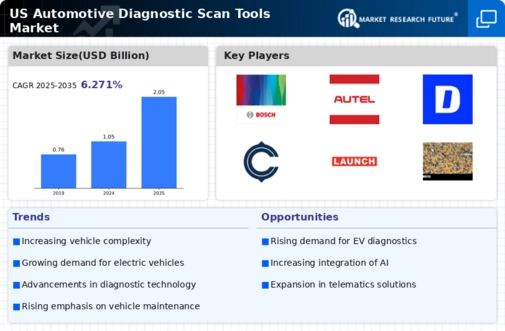Rising Vehicle Electrification
The automotive diagnostic-scan-tools market is experiencing a notable shift due to the increasing electrification of vehicles. As more electric and hybrid vehicles enter the market, the complexity of their electronic systems necessitates advanced diagnostic tools. In 2025, it is estimated that electric vehicles will account for approximately 25% of new car sales in the US. This transition requires specialized diagnostic equipment capable of interfacing with high-voltage systems and battery management systems. Consequently, manufacturers of diagnostic tools are adapting their products to meet these new demands, thereby driving growth in the automotive diagnostic-scan-tools market. The need for precise diagnostics in electric vehicles is likely to enhance the market's value, as technicians require sophisticated tools to ensure optimal performance and safety.
Increased Focus on Vehicle Safety
The automotive diagnostic-scan-tools market is increasingly driven by a heightened focus on vehicle safety. As consumers become more aware of safety features and regulations, there is a growing demand for diagnostic tools that can assess and ensure the functionality of safety systems. In 2025, it is anticipated that safety-related diagnostics will account for a significant portion of the market, as vehicles are equipped with advanced safety technologies such as collision avoidance systems and adaptive cruise control. This trend compels automotive service providers to invest in diagnostic tools that can effectively evaluate these systems. Consequently, the automotive diagnostic-scan-tools market is likely to experience growth as safety becomes a paramount concern for both consumers and regulatory bodies.
Integration of Advanced Technologies
This market is poised for growth due to the integration of advanced technologies such as artificial intelligence (AI) and machine learning (ML). These technologies enable diagnostic tools to analyze data more effectively, providing technicians with deeper insights into vehicle performance and potential issues. As of 2025, the adoption of AI-driven diagnostic tools is expected to rise, enhancing the accuracy and efficiency of vehicle diagnostics. This trend indicates a shift towards more intelligent systems that can predict failures before they occur, thereby reducing repair times and costs. The automotive diagnostic-scan-tools market is likely to expand as manufacturers innovate and develop tools that leverage these technologies, ultimately improving service delivery and customer satisfaction.
Expansion of Automotive Aftermarket Services
The automotive diagnostic-scan-tools market is benefiting from the expansion of aftermarket services in the US. As vehicle owners increasingly seek reliable and cost-effective maintenance solutions, independent repair shops and service centers are investing in advanced diagnostic tools to remain competitive. The aftermarket sector is projected to grow at a CAGR of 4.5% through 2025, indicating a robust demand for diagnostic equipment. This trend is further fueled by the rising complexity of modern vehicles, which require specialized tools for accurate diagnostics. Consequently, the automotive diagnostic-scan-tools market is likely to see increased sales as service providers upgrade their equipment to meet customer expectations and enhance service quality.
Regulatory Compliance and Emission Standards
The automotive diagnostic-scan-tools market is significantly influenced by stringent regulatory compliance and emission standards imposed by government agencies. In the US, the Environmental Protection Agency (EPA) has established rigorous guidelines for vehicle emissions, compelling manufacturers to equip their vehicles with advanced diagnostic systems. As of 2025, compliance with these regulations is mandatory, leading to an increased demand for diagnostic tools that can accurately assess emissions and ensure adherence to standards. This regulatory landscape not only drives the need for sophisticated diagnostic equipment but also encourages innovation within the automotive diagnostic-scan-tools market. The market is expected to grow as automotive service providers invest in tools that facilitate compliance, thereby enhancing their service offerings and operational efficiency.
























Leave a Comment